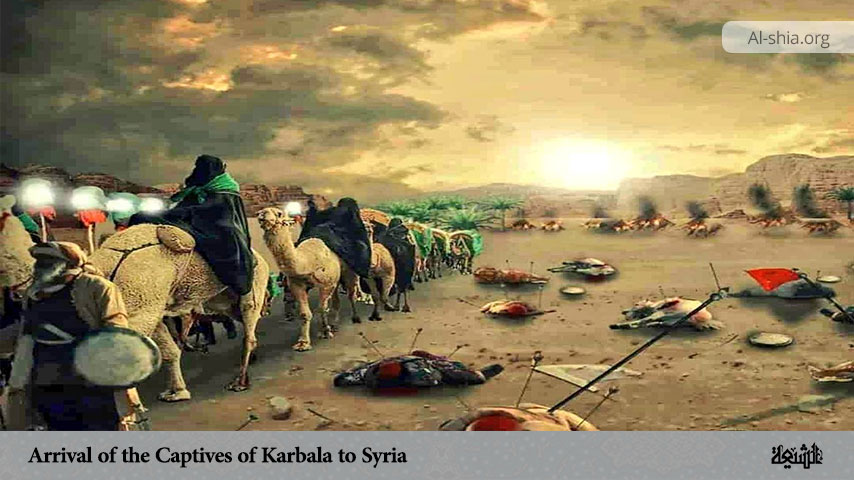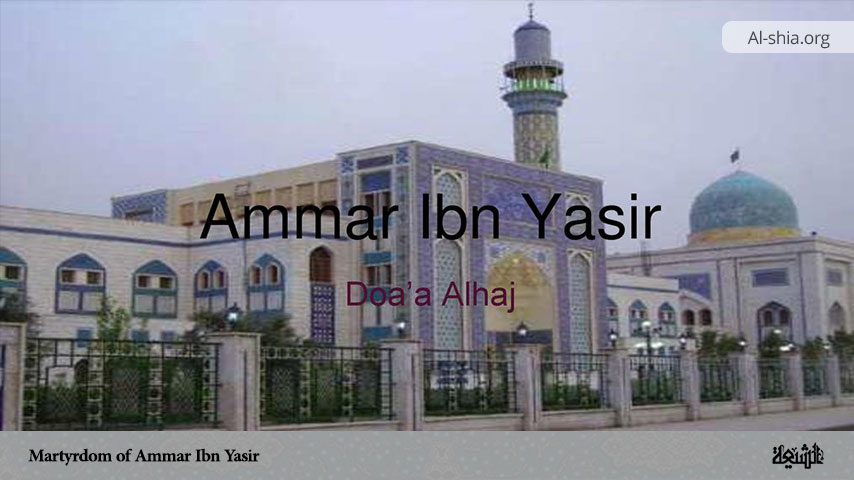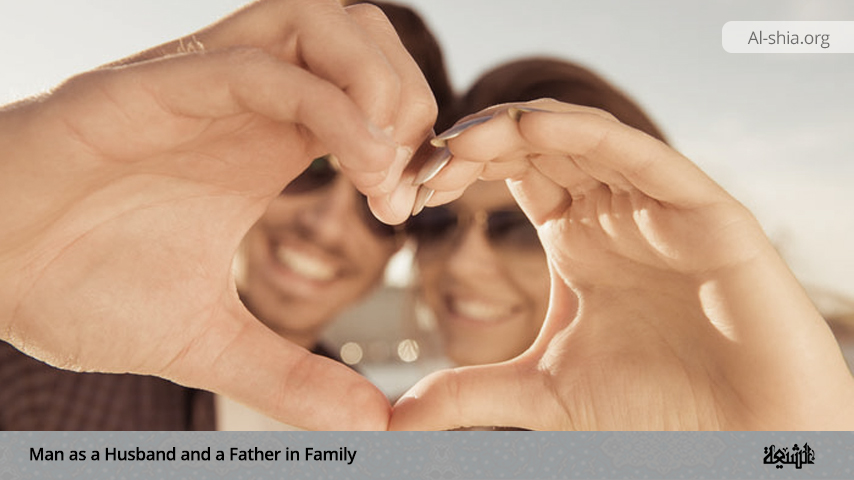The Battle of Karbala is the most sorrowful incident in the history of Islam, in which the beloved grandson of the Holy Prophet, Imam Husain (PBUH) fought against the army of Yazid ibn Mu’awiya (the second Umayyad caliph), who was a tyrant leader of the Muslim community. On the land of Karbala, two armies engaged in battle on the Day of ‘Ashura, i.e., Muharram 10, 61 AH (correspondence to October 10, 680 BC). In this battle, Imam al-Husain (PBUH), his brother, ‘Abbas ibn ‘Ali (PBUH), the two sons, ‘Ali al-Akbar and ‘Ali al-Asghar, 17 members of Banu Hashim, along with more than fifty companions of Imam Husain (PBUH) were martyred.
After the martyrdom of Imam Husain (PBUH), the army of the enemy attacked the tents of Imam Husain (PBUH) and took away anything they could as booties, including the earrings, necklaces etc. of daughters. It is reported that Shimr rushed to the tents of the family of Imam (PBUH) with a group of soldiers to kill Imam Ali Zayn al-Abideen (PBUH) who was ill then, but Lady Zaynab (s.a) did not let them do so. Thus, the remaining members of Imam Husain’s family, including his sister, Lady Zaynab bint Ali; and his surviving son, Ali Zayn al-Abideen and the families of some of the martyrs of Karbala were taken by the army as prisoners of war and they were thereafter sent to the court of ‘Ubaydullah ibn Ziyad in Kufa and thereafter to the court of Yazid in Syria.
Historians disagreed about the number of captives from Ahl al-Bayt (PBUH) and the survivors of Imam al-Husain’s companions. Some sources reported that there were 61 women among the captives. The enemy army mounted the captives on bareback camels and horses. When they entered Kufa, people came out to see them; the women of Kufa were crying for them. Meanwhile, there is no explicit report about the exact date of their arrival to Kufa in early sources. However, according to a sentence of al-Sheikh al-Mufid, they entered Kufa on Muharram 12 61 AH (correspondence to October 12, 680 BC). The captives were therefore taken to the palace of ‘Ubaydullah ibn Ziyad in Kufa. A harsh conversation between Lady Zaynab (s.a) and Ubaydullah is reported.
Ubaydullah sent a group of soldiers along with the captives to Damascus. Famous people such as Shimr ibn Dhi l-Jawshan and Tariq ibn Muhaffiz ibn Tha’laba were among them. According to Ibn A’tham and al-Khwarizmi, the soldiers and agents of ‘Ubaydullah ibn Ziyad mounted the captives on uncovered howdahs, moved them from city to city and treated them like infidel captives.
Imam Ali Zayn al-Abideen (PBUH) while narrating his experience in this journey said: “They mounted me on a crippled skinny camel with a wooden howdah that did not have any mat in it, while the head of Imam Husain (PBUH) was at the top of a spear and the women were behind me, and the spears were around us. If any of us shed a drop of tear, they would hit him on the head by the spears; until we arrived in Damascus. When we entered Damascus, I heard someone shouting: O people of Damascus! These are the captives of a cursed household![1]”
Meanwhile, before the arrival of the captives in Damascus, Yazid gave his orders to decorate the city. Sahl ibn Sa’d al-Sa’idi is one of the narrators who reported that the city was decorated and people were happy when the captives entered the city[2].
According to historical reports, the captives and the heads of martyrs of Karbala entered Damascus on Safar 1 from Bab Tuma or Bab al-Sa’at[3]. They were taken to Umayyad Mosque and were kept on a raised platform there. Thereafter, Yazid ordered to decorate his palace and invited the elites of Damascus, then ordered to bring the captives into his palace. Reports denote that they brought the captives into the palace while they were tied to each other by ropes.
In the presence of the captives, Yazid had put the head of Imam Husain (PBUH) in a gold tub and was hitting it with his staff. When Sukayna and Fatima, the daughters of Imam Husain (PBUH), saw that; they shouted crying. It is narrated from Imam al-Rida (PBUH) that Yazid put the head of Imam Husain (PBUH) in a tub then put his food table on it, and started eating and drinking wine at that table with his companions. Then they put the table of Chess on that tub and started playing it. Whenever he won, he drank a glass of wine and poured the rest of it on the ground near the tub which was the head of Imam Husain (PBUH)[4].
Some people who were present opposed Yazid’s actions, including Yahya ibn al-Hakam, Marwan ibn al-Hakam’s brother, whom Yazid punched on his chest, and Abu Barza al-Aslami, whom Yazid ordered to be taken out of the palace.
At the moment Imam Ali Zayn al-Abideen (PBUH) and Lady Zaynab (s.a) discovered that the people of Damascus did not know anything about the real Islam and the high status of Ahl al-Bayt (PBUH), they delivered sermons to inform people about the tyranny of Umayyad dynasty and enlighten them about the truth[5].
According to historical and narrative sources, Ahl al-Bayt, peace be upon them resided in two locations in Damascus. First: a roofless ruins, in which the story of Lady Ruqayya took place. The captives were there for two days; however, after the sermons of Imam Ali Zayn al-Abideen (PBUH) and Lady Zaynab (s.a), the public opinion changed about Ahl al-Bayt (PBUH) and Yazid had to move them to a house near his palace[6].
It is suggested by some hadiths that the captives of Karbala were in terrible conditions in the Ruins. They were bothered by the sunshine, and as a result, their face skins were peeled. They recited elegies and cried for Imam Husain (PBUH) there. According to some hadiths, Yazid had appointed guards on the Ruins who did not know Arabic. There is a disagreement over how long the Captives of Karbala stayed in the Ruins. According to some sources, they were confined in the ruins until their face skins were peeled. According to some authors, they stayed in the Ruins of al-Sham for about one week.
According to some sources, one of Imam Husain’s young daughters died in the Ruins of Damascus. On these sources, she had longed for her father. Yazid commanded that Imam Husain’s head be taken to her. She held her father’s head in her arms and cried until she died. Some later sources referred to the girl as Ruqayya. The famous shrine attributed to Ruqayya is built in this place.
According to some historical sources, Sukayna had a dream on the fourth day of their stay in Damascus. According to Ibn Nama al-Hilli, she dreamt of the Prophet Muhammad (peace be upon him and his family), prophets Adam, Abraham, Moses, and Jesus visiting Imam Husain in Karbala, while the Prophet (PBUHH) had grabbed his beard with his hand, sometimes falling on the ground and then standing up. Lady Fatima (PBUH), Eve, Asiya, Maryam, and Khadija were also there, while Fatima Zahra had put her hand on her head, sometimes falling on the ground and then standing up. In the dream, Sukayna approached Lady Zahra and started to cry. Fatima Zahra told her, “Dear Sukayna! Stop crying. Your moans are burning and breaking my heart. This cloth has your father’s blood on it. I will not put it aside until I meet God”.
Most historians said that captives stayed in Damascus for three days; however ‘Imad al-Din al-Tabari said that they stayed there for 7 days. In another account, Sayyid ibn Tawus said that they stayed for a month; nonetheless, he pointed out that this report is not reliable. Similarly, the exact date of the departure of captives from Damascus is unknown. There is a disagreement among scholars about whether the captives passed by Karbala on their way back to Medina or not.
When the captives of Karbala got near Medina, Imam Ali Zayn al-Abideen (PBUH) ordered them to camp outside the city and sent Bashir ibn Hadhlam to the city to inform the people about the martyrdom of Imam Husain (PBUH).
Bashir went to al-Masjid al-Nabawi and recited this poem while crying: “O people of Medina! Do not stay in Medina anymore; al-Husain has been killed, so weep copiously. His body, in Karbala, soaked in blood and his head, on the top of the spear, is circled.”
Bashir informed the people that Imam Ali Zayn al-Abideen (PBUH) and other members of Ahl al-Bayt had camped outside the city. By hearing the news, the women of Medina came out of their houses crying, weeping, and shouting. No day people were seen crying like that day; it was the saddest day for Muslims after the demise of the Messenger of Allah[7] (PBUHH).
Footnotes:
[1] . Ibn Ṭāwūs, Iqbāl al-Aʿmāl, vol. 3, p. 89.
[2] . Ṣadūq, al-Amālī, p. 230.
[3] . Abū Riyḥān al-Bīrūnī, Āthār al-bāqiya, p. 527.
[4] . Ṣadūq, ʿUyūn akhbār al-Riḍā, vol. 1, p. 25.
[5] . Ibn Ṭāwūs, al-Malhūf, p. 213-218.
[6] . Mufīd, al-Irshād, vol. 2, p. 122.
[7] . Ibn Ṭāwūs, al-Malhūf, p. 227.


















